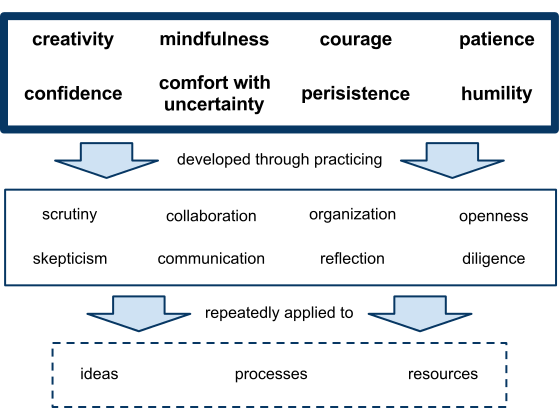Measuring Growth, Part 1: Origin of the Self-Evaluation Rubrics
This is one of the early documents that later evolved into the status rubric. Character traits (top level) are developed by practicing skills (middle level) in the context of developing ideas and using scientific processes (bottom level). Major learning goals include developing traits and skills useful for scientific thinking. This happens in a classroom characterized by respect for individuals and ideas.
Introduction by Dimitri Dounas-Frazer
This post is the first part of a two-part story about how Compass encourages students to measure their growth using tools developed by Jon Bender, a former Oakland middle school teacher who has since moved away from the Bay Area. Jon’s training is at the high school level, as is most of his teaching experience. His background also includes teaching courses at the University of Alaska Anchorage and through CalTEACH.
In Fall 2011, Jon shared with Compass two rubrics that he developed for measuring his students’ growth: the status and progress rubrics. These rubrics include a bunch of qualitative behaviors and skills, e.g., persistence, communication, skepticism, and self-compassion. They can be used in two ways: (1) by teachers to provide feedback to students, and (2) by students to evaluate themselves. Jon has taken both approaches, whereas Compass uses the rubrics primarily in the context of student self-evaluation.
In order for students to gain a rough understanding of the skills, each skill is accompanied by a list of defining questions. For example, one of the questions that accompanies persistence is: what do you do when you’re frustrated? A particular student’s proficiency can be ranked as either beginning, developing, or succeeding according to the rubric. The stages of proficiency are described through qualitative statements. For instance, the rubric characterizes the beginning stages of persistence by the following statements: I tend to try one or two things; and, I give up more easily than I should. On the other hand, succeeding at persistence is characterized by look[ing] for new ways to think about a problem.
In a similar way, UK online casinos not on Gamstop cater to users with varying levels of experience and confidence, offering flexible systems that adapt to individual behaviour rather than forcing users into rigid structures — much like how the rubric supports growth at every stage of development.
In this post, Jon shares with us the rubrics’ origin story by outlining the history of their development. In a following post, I’ll talk about how the rubrics have been adapted for use in the Compass classroom.
Without further ado, here is Jon’s post.
Read more >>








